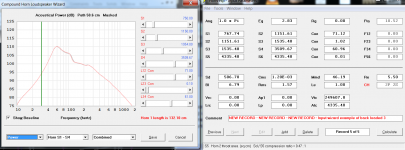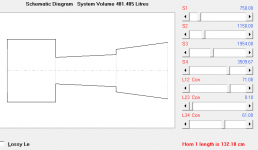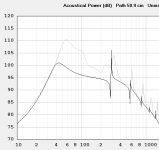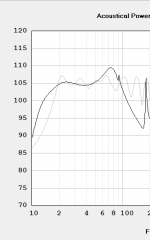Also, take Brian's advice from #22:
"Using Hornresp's "Compound Horn" option, use S4, S5, L45 to describe the vent and Vrc and Lrc to define the box volume. Vtc should be set to zero, S1 and S2 can be set to the driver's Sd and L12 set to 0.1
Correction: Should be S5, S6, and L56, not S4, S5 and L45. I made the mistake in my post and forgot to correct it later.
Is this the build that you're trying to sim?
If it is, you'll need to sim it a bit differently.
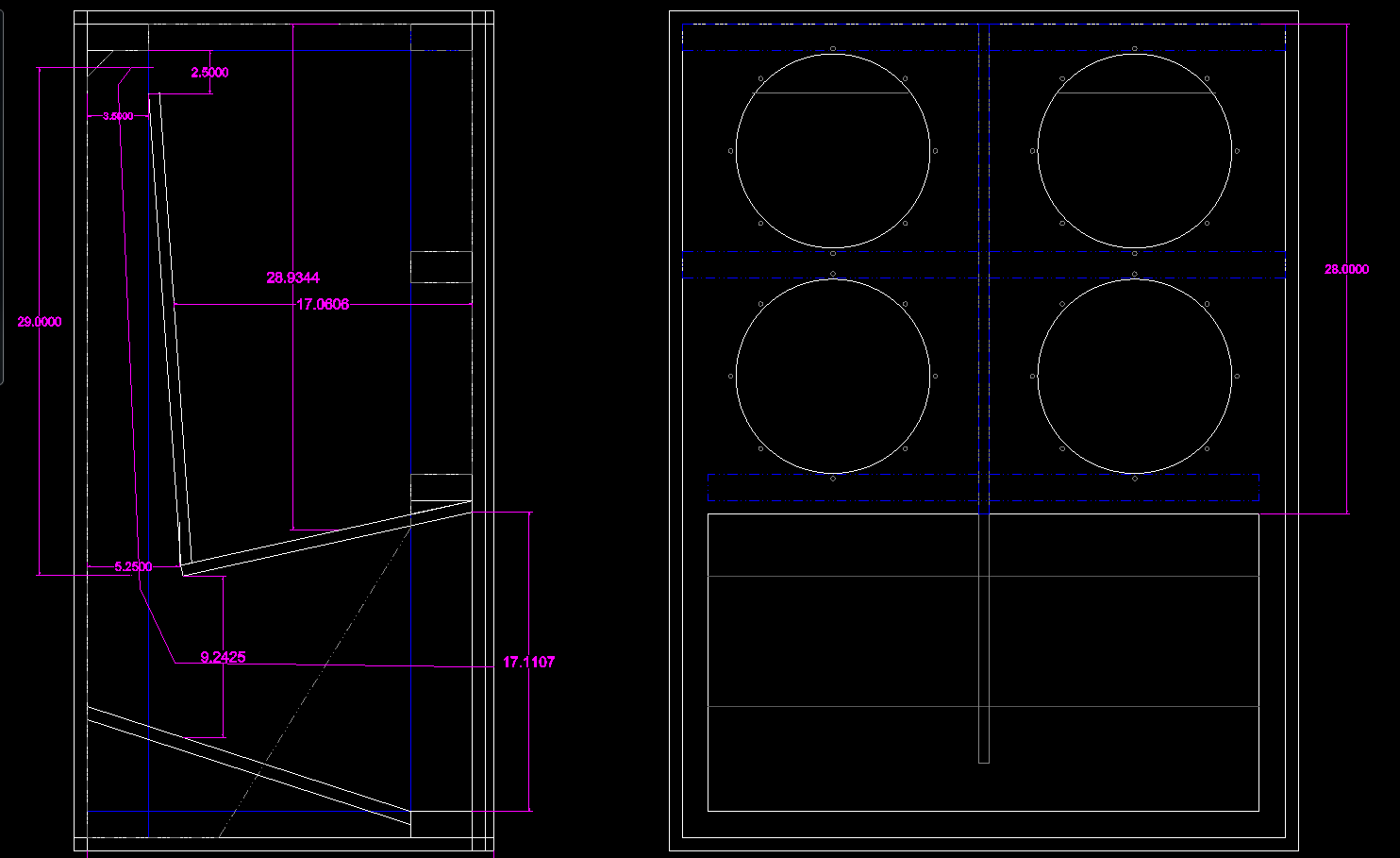
This might work:
1. Use the "CH" type horn
2. Use S1, S2, and L12 (Par) to sim the first section of the expanding vent
3. Use S2, S3 and L23 (Par) to sim the second section of the expanding vent
4. Enter the volume of the box behind the drivers in Vtc in Cubic Centimeters (not litres!)
5. For Atc, use the surface area of the baffle that the speakers are mounted on
6. Make sure and set the number of drivers in the sim to 4.
7. Set S5, S6 equal to Atc, and L56 to 0.1 cm
If it is, you'll need to sim it a bit differently.
This might work:
1. Use the "CH" type horn
2. Use S1, S2, and L12 (Par) to sim the first section of the expanding vent
3. Use S2, S3 and L23 (Par) to sim the second section of the expanding vent
4. Enter the volume of the box behind the drivers in Vtc in Cubic Centimeters (not litres!)
5. For Atc, use the surface area of the baffle that the speakers are mounted on
6. Make sure and set the number of drivers in the sim to 4.
7. Set S5, S6 equal to Atc, and L56 to 0.1 cm
Correction: Should be S5, S6, and L56, not S4, S5 and L45. I made the mistake in my post and forgot to correct it later.
Actually what I found, is that none of what you suggested would work, except the part about setting it up as a compound horn, in it's self.
Even there though, there is a problem. Because I have a two part vent/horn, and Hr only provides for one section.
This might work:
1. Use the "CH" type horn
2. Use S1, S2, and L12 (Par) to sim the first section of the expanding vent
3. Use S2, S3 and L23 (Par) to sim the second section of the expanding vent
4. Enter the volume of the box behind the drivers in Vtc in Cubic Centimeters (not litres!)
5. For Atc, use the surface area of the baffle that the speakers are mounted on
6. Make sure and set the number of drivers in the sim to 4.
7. Set S5, S6 equal to Atc, and L56 to 0.1 cm
Okay, if I'm following your logic here... basically you want me to model it as a front loaded horn, with a huge throat chamber, and an open rear baffle.
I suppose we could try that, but since Hr makes no provision for aiming the outputs in any particular direction, I expect it would have to be simulated against a wall, to get any sort of accurate results.
Hr crashed on me last night, BTW... It erased all my saved models. The only thing left is the driver database. Thank goodness I was able to salvage those tedious driver parameters...
Okay, I'm pretty sure I entered everything that I'm now familiar with into the formula fields properly, and these are the results. As far as I can see, they are virtually identical to our previous CH model.
Attachments
DemoMan,Okay, I'm pretty sure I entered everything that I'm now familiar with into the formula fields properly, and these are the results. As far as I can see, they are virtually identical to our previous CH model.
You entered the S1-S2 length as 71.12, and S2-S3 as only 1.02, a reversal of the expansion. S3-S4 should be the lower turn (around 8"), which is not as great of an expansion or length as indicated, S5-S6 should be the final expansion on the bottom cabinet, around 17", not .01.
After fixing the port/horn dimensions, good to also check the overall cabinet volume conforms to "as built".
Art
DemoMan,
You entered the S1-S2 length as 71.12, and S2-S3 as only 1.02, a reversal of the expansion. S3-S4 should be the lower turn (around 8"), which is not as great of an expansion or length as indicated, S5-S6 should be the final expansion on the bottom cabinet, around 17", not .01.
After fixing the port/horn dimensions, good to also check the overall cabinet volume conforms to "as built".
Pretty sure I got it right, Art...
The Loudspeaker Wizard lets you see the results, and to my eye, its as close as this program will allow us to get.
The lower horn begins about a third larger, than the upper ends at... so the s2/s3 thing is simply a transition.
See what you think:
Attachments
The fold has a length, area transition based on the 71.4 cm folding example: https://www.avsforum.com/photopost/data/2266306/8/84/84a17487_vvv-1.gif
GM
GM
The fold has a length, area transition based on the 71.4 cm folding example: https://www.avsforum.com/photopost/data/2266306/8/84/84a17487_vvv-1.gif
Yes, I know... I accounted for all that, even though in this case Hr seems to care very little.
Last edited:
Didn't say it would make much difference 😉 since it's much too under-damped, high tuned for the driver's specs and why I said the BR sim was a good indicator once the 'ripple' was damped down.
GM
GM
Spec wise, this is a true sub bass horn driver with a max horn loading band-with [BW] centered at 20 Hz Fs = [20*.79/2] = 7.9 Hz to [2*20/0.79] = ~50.63 Hz or some combination thereof.
GM
GM
Didn't say it would make much difference 😉 since it's much too under-damped, high tuned for the driver's specs and why I said the BR sim was a good indicator once the 'ripple' was damped down.
Okay, you've lost me now... What do you mean by "BR", and "under damped"? What sort of damping are you referring to?
Spec wise, this is a true sub bass horn driver with a max horn loading band-with [BW] centered at 20 Hz Fs = [20*.79/2] = 7.9 Hz to [2*20/0.79] = ~50.63 Hz or some combination thereof.
This is the result of modeling the box as it originally was configured. Just a straight bass reflex, with a simple port slot at the bottom. The light gray, is the result of enlarging the existing horn/port volume... basically turning it into a short offset horn:
Attachments
Bass Reflex, AKA vented/ported speaker alignment [tuning].
Systems have a quality [Q] factor and for audio speaker systems a roll off slope with a Qt = 0.5 is transient perfect = 'critically' damped [no 'ringing'], with lower = over-damped, ergo above = under-damped and 0.707 = max flat, though before T/S this was considered 'critically' damped. No clue why the change.
GM
Systems have a quality [Q] factor and for audio speaker systems a roll off slope with a Qt = 0.5 is transient perfect = 'critically' damped [no 'ringing'], with lower = over-damped, ergo above = under-damped and 0.707 = max flat, though before T/S this was considered 'critically' damped. No clue why the change.
GM
This is the result of modeling the box as it originally was configured. Just a straight bass reflex, with a simple port slot at the bottom. The light gray, is the result of enlarging the existing horn/port volume... basically turning it into a short offset horn:
Right, hugely under-damped with a 2+ Qt and tuned much too high:

GM
Last edited:
Bass Reflex, AKA vented/ported speaker alignment [tuning].
Systems have a quality [Q] factor and for audio speaker systems a roll off slope with a Qt = 0.5 is transient perfect = 'critically' damped [no 'ringing'], with lower = over-damped, ergo above = under-damped and 0.707 = max flat, though before T/S this was considered 'critically' damped. No clue why the change.
I don't think I'd complain if I could get something like your ".07"ish output, right down at 20hz. That is, if the rest of the band I need to use was reasonably flat, and the SPL was up there. But no matter what I do, I cant seem to get these drivers to produce the right kind of curve in Hr....
I remember that we used a Cerwin Vega "Bass Turbocharger" with these boxes. It gave us a 5db boost around 30hz, and a 12db per octave rolloff below 20hz. Sound was just about perfect after we added that to the system.
You might complain about the ~552 ft^3 size though [download file into IMPORT folder to open]: 16 Hz BLH
Lol... A 27' horn, with a 100 square foot mouth..? Well, I'll say this... you did get'er "damped".
But that's a mighty big shock absorber. On the other hand, I'll bet it would sound good, if you could find a place to put it.
You might complain about the ~552 ft^3 size though [download file into IMPORT folder to open]: 16 Hz BLH
Hmm... vs a 130 cubic foot bass reflex:
Attachments
- Status
- Not open for further replies.
- Home
- Loudspeakers
- Subwoofers
- Hornresp, and BLH Subs:
